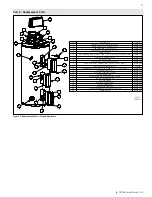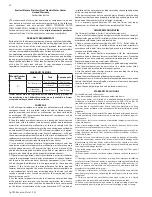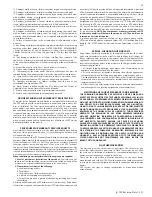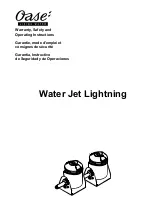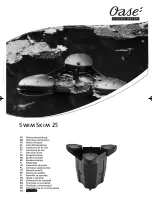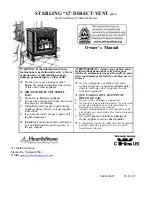
lp-790 Revision Date 1.3.22
14
Part 7 - Maintenance
Considerations
•
To avoid electric shock, disconnect electrical supply before
performing maintenance.
•
To avoid severe burns, allow heater to cool before performing
maintenance.
NOTE:
In addition to the routine maintenance detailed in this manual,
this water heater should be inspected annually by a qualified service
technician to assure that all the equipment is operating safely and
efficiently. The owner should make necessary arrangements with a
qualified heating contractor for periodic maintenance of the heater.
Installer must also inform the owner that lack of proper care and
maintenance may result in a hazardous condition, premature heater
failure, and void the warranty.
Routine preventative maintenance ensure the water heater
operates safely and efficiently over its service life. The
Owner / User
may perform the maintenance activities described below.
Monthly (Every two weeks in hard water locations)
It is recommended that a few quarts of water be drained from the
heater. This will flush sediment deposits from the bottom of the
heater and lengthen the heater’s service life. Turn off power to
the heater during flushing operation, so the elements will not be
damaged.
Failure to shut off the heater when draining may damage the
heating elements. Operating a partially filled / empty water
heater could lead to damage from “dry-firing”. Failures due to such
damage ARE NOT covered by warranty.
To flush the tank, attach a hose to the field installed drain valve.
Close the cold water supply line shut-off valve. Open the drain valve
and hot water faucet(s) to vent heater while draining. Direct the flow
of water to a drain or bucket where it will not cause damage.
Flush until water runs clear to complete this operation. Close drain
valve and reopen the supply line shut-off valve. Close the hot water
faucet(s) once all air has been bled from the system (when water
runs freely). Make certain that the heater is completely full of water
before restoring power.
Periodically (At least twice a year)
Check around the water heater and related plumbing for leaks. If
the combination temperature and pressure relief valve discharges
periodically, or water is leaking from around the heating elements,
there may be a problem with your water system. DO NOT ATTEMPT
TO REPAIR LEAKS YOURSELF! Contact a qualified service contractor
for assistance.
Check the area around the water heater for flammable liquids or
combustible materials. If any are found, remove from the area.
Vacation (Extended shut-off periods)
During extended mild or warm weather periods when hot water will
not be in use, lower the setpoint temperature on the water heater.
When hot water is needed again, raise the setpoint temperature on
the water heater.
Drain the water heating system (as detailed in this section) if the
water heater will be shut off and exposed to freezing temperatures.
Fill the water heating system (as detailed in this section) when
Water drained from the water heater may be scalding hot. Take
care to avoid scalding. Wear gloves and safety glasses, and direct
water to a safe drainage location. It is recommended to turn
power off to the water heater and run water at a hot water faucet
until it cools BEFORE draining water from the heater. Failure to
comply with this warning could result in property damage, severe
personal injury, or death.
hot water is needed again. Contact a qualified service contractor for
assistance if necessary.
Water drained from the water heater may be scalding hot. Take care
to avoid scalding. Wear gloves and safety glasses, and direct water to
a safe drainage location. It is recommended to turn power off to the
water heater and run water at a hot water faucet until it cools BEFORE
draining water from the heater. Failure to comply with this warning
could result in property damage, severe personal injury, or death.
T&P Relief Valve Maintenance Instructions:
•
Annually:
Certain naturally occuring mineral deposits may
adhere to the valve, blocking waterways and rendering the
valve inoperative. The T&P Relief Valve lever must be operated
to ensure the waterways are clear. If waterways are clear, hot
water will discharge from the valve. Take precautions to avoid
personal injury and property damage from contact with hot
water. Before operating lever, check to see that a discharge
line is connected to the valve, directing the flow of hot water
from the valve to a proper place of disposal.
•
Replacement of the valve is required if no water flows when
the lever is operated. Turn the water heater off until the valve
is replaced.
•
If water flows from the valve, drain a few gallons from the tank
to ensure the water flows freely.
•
At least once every three years:
To ensure that the T&P
valve has not been affected by corrosive water conditions
and that the valve and discharge line have not been altered
or tampered with illegally, relief valves should be inspected,
and replaced, if necessary, by a licensed plumbing contractor
or qualified service technician.
Failure to comply with these guidelines could result in failure
of relief valve operation, and possibly result in substantial
property damage, severe personal injury, or death.
The maintenance activities described below are only to be performed
by the
Installer / Qualified Service Provider
. These maintenance
items should be performed during recommended
annual
service and
any service calls.
1. Ask the owner / user if there have been any issues with the water
heater. Diagnose any heater issues and repair / replace parts as
necessary.
2. Check the water heater and related plumbing for leaks. Repair any
that are found.
3. Check the area around the water heater for flammable liquids or
combustible materials. If any are found, remove from the area.
4. Check the heating elements while the heater is in operation. If
the elements are hissing / singing excessively, they may need to be
cleaned. Inspect the elements and clean if necessary.
5. Inspect the Temperature and Pressure (T&P) Relief Valve. See
instructions below.
6. Check the operation of the mixing valve by measuring the
temperature at a hot water faucet. Ensure the outlet temperature is
5
o
F of the desired outlet temperature. If the outlet temperature
is out of range, adjust the tank booster valve as described in this
manual. Replace the tank booster mixing valve if the desired outlet
temperature cannot be reached.
7. Turn power supply off to the water heater. Open the drain valve
and drain a few gallons of water from the tank to clear any hard water
deposits. Once complete, close the drain valve and restore power to
the water heater.
8. Inspect / replace the anode rod.

















